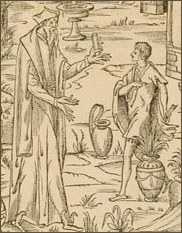Les livres d'architecture
| Author(s) | Bourdin, Pierre Boudan, Alexandre |
|---|---|
| Title | Le premier inventaire des termes et pieces de la fortification... |
| Imprint | [Paris, F. Pellican, 1639 ?] |
| Localisation | La Flèche, Prytanée national militaire, D224-Res |
| Subject | Astronomy, Geometry, Military architecture, Optical science, Perspective |
Le premier inventaire des termes et pieces de la fortification : primus nomenclator militaris is a rare book; the only copy presently listed in French collections is the one in the library of the Prytanée National Militaire in La Flèche. It has been attributed to Father Pierre Bourdin (1595-1653), a member of the Society of Jesus, who taught mathematics, optics, cosmography, drawing and fortification design for eighteen years at La Flèche, then at the collège Clermont in Paris. A prolific author, Bourdin is primarily known for his mathematics textbook which came out in three editions, of which two were posthumous, between 1645 and 1661 and for his criticism of Descartes’ Optiques during a quarrel which opposed “les professeurs de la Flèche” and the philosopher. The signed soft point engravings which accompany Le premier inventaire are the work of Alexandre Boudan (d. 1671), an editor and printer to the king, a print merchant in Paris, rue Saint-Jacques, at “La Corne du cerf” in approximately 1633. His address was “l’Image Saint-Maur” from 1643 on. Boudan had previously executed the plates of the first Cours de mathématique abrégé et clairement représenté par figures… (Paris, 1641).
As its title indicates, Bourdin’s work offers a list of terms linked to military art, illustrated by Boudan’s plates. Unpaginated, the copy at the library of the Prytanée National Militaire in La Flèche bears a handwritten table of contents on the title page entitled “tabula hujus libri”, illustrating the diversity of themes treated. Under the cover of a work devoted to the terms relating to fortification, in fact Bourdin develops approximately thirty widely varied themes such as optics, music, balistics, cosmography, the manufacture of globes, drawing and perspective. The rather disorganized composition of the whole lends one to think that this book could be a compilation of current works or a printed summary, a teaching tool (primarily for his mathematics courses). The different border decorations of certain chapters would have us lean in this direction. A sale recorded in February 2008 in Fontainebleau gives the date 1639 for a first edition with an identical title at the shop of François Pelican, but with a slightly different composition. This early date which corresponds to the years Bourdin taught and to his first connection with Alexandre Boudan would support this hypothesis. It would be interesting to compare the book with Pierre Bourdin’s handwritten texts found at the Bibliothèque nationale de France (BnF, mss lat. 17861-17862) as well as with the copy listed at the Yale University Library in the United States under the title Iconographia cursus mathematici .
Le premier inventaire is linked to the series of publications created by the professors at the Society of Jesus schools such as Georges Fournier, Pierre Ango and Claude Milliet de Chales. Intended for the teaching of applied mathematics, drawing and the art of fortification to young noblemen, these compilations aim at inculcating the fundamentals of military arts among an elite for whom “fortifier régulièrement et tirer des plans” was essentially a courtly art. In contrast to contemporary books written by engineers in the field such as Jean Errard de Bar-le-Duc or Blaise de Pagan, it was essentially important for the teachers in the Society of Jesus schools to provide “une bonne teinture” in the military arts to the young officers and the king’s future cadets. The themes Bourdin chose for his list reveal particulary well the prevalent tastes and tendancies of the French nobility at the dawn of Louis XIV’s reign. The art of representation and drawing occupy a large space, running parallel with the affirmation of a “national” military style which would go beyond that of the Italian and Dutch schools. Bourdin’s attempt to define a French military order in the image of the orders of civil architecture is entirely representative of it. This theme which he would develop in greater detail in his book L’architecture militaire ou l’art de fortifier les places régulières et irrégulières , published in 1655 at Guillaume Bénard’s shop, was used again by Alain Manesson Mallet in his military best seller, Les Travaux de Mars .
Emilie d’Orgeix ((Institut National d’Histoire de l’Art, Paris)
Sylvie Tisserand (Library of the Prytanée national militaire, La Flèche) – 2008
Emilie d’Orgeix ((Institut National d’Histoire de l’Art, Paris)
Sylvie Tisserand (Library of the Prytanée national militaire, La Flèche) – 2008

